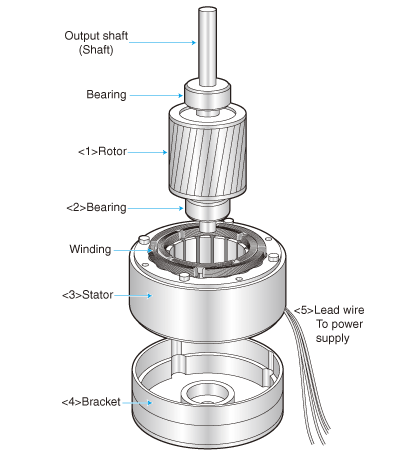1-2. Components of a Motor
Motor components are classified into five main portions (1) to (5) as Fig. 1.2 shows.

- (1) Rotor
- Rotating part
- (2) Bearing
- Supporting part of the rotating shaft of the rotor
- (3) Stator
- Part generating force used to rotate the rotor
- (4) Bracket or end plate
- Bearing supporting part integral for the stator
- (5) Lead wire
- Wire connected to the drive circuit supplying power to the motor or wire connected to the power supply
Stator
Of these components, the parts most closely related to the basic classification method for motors are the stator and the rotor. The following four types are listed as the typical stator structure:
- A: Stator of distributed winding
- B: Stator of concentrated winding
- C: Inductor stator
- D: Permanent magnet stator
Rotor
Rotors can be classified into 10 different types.
- (1) Squirrel-cage rotor
- (2) Salient-poled squirrel-cage rotor
- (3) Semi-hard steel rotor
- (4) Soft-steel rotor
- (5) Salient-poled lamination rotor
- (6) Soft-steel rotor with fine teeth
- (7) Permanent-magnet rotor
- (8) Inductor rotor
- (9) Winding rotor
- (10) Commutator rotor
In the following Section 1.3, we will discuss how various types of motor are classified by combining the stator and the rotor from among the above-listed stator A to D and rotor (1) to (10).
Motor-configuring material
The following is a brief explanation of principal materials in a motor:
- (1) Wire
-
Wire is the material the current travels through. The wire is also called a conductor. Wires are typically made of copper; however, aluminum is occasionally used.
Lead wire is used to supply power to the motor from the power supply and for the winding that is wound and connected inside the motor. In English, winding is called magnet wire, which is the wire used to generate a magnetic field. In Japan, winding is also referred to as enameled wire after the enamel resin that is used as insulation material (to be described).
At present, high-polymer materials are used for insulation, but habitual naming criteria of enameled wire are still used.
As a component of motor winding, the term "enameled wire" is used in Japanese. Enameled wire is referred to as magnet wire in English.
- (2) Core
-
(Iron) core is the path for flux and is made of iron as the name (iron) core suggests. Moreover, a core used to combine two magnets with flux is called a yoke.
Iron for mechanical structures and that for cores contain different types of accessory ingredients. Iron for mechanical structures contains carbon (C), while iron for cores is mixed with silicon (Si) and called silicon steel. In the case of a motor, the core is divided into the stator core and the rotor core, and a magnetic circuit is configured through the air gap in between. Since the magnetic pole of the stator core configuring the magnetic circuit of electromagnetic field DC motors is excited by direct current, the core does not need to be laminated; soft steel is used instead.
On the other hand, laminated core is used for a rotor core configuring the armature circuit as the flux changes with rotation. Also, permanent magnets are often used for the magnetic pole of small DC motors. Cores for the stator of synchronous motors and the stator and rotor of induction motors are excited by alternating current, therefore laminated core is used for each of them.
- (3) Insulator (Insulating material)
-
Insulators prevent electric current from flowing to any locations other than the desired one, and materials that have such characteristics are called insulating materials.
Rubber, enamel, and other high-molecular compounds or resins, paper, mica, glass fiber, etc. are used as insulators.
- (4) Permanent magnet
- Among materials that make up a motor, a permanent magnet is important as it generates magnetic fields. Permanent magnets can be said to be a type of iron-based alloy or oxide.

Stator and rotor in different languages
The following is a summary of nominal designations for the stator and the rotor in different languages.